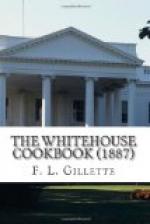This recipe for making superior jelly without heat is given in a Parisian journal of chemistry, which may be worth trying by some of our readers. The currants are to be washed and squeezed in the usual way, and the juice placed in a stone or earthen vessel, and set away in a cool place in the cellar. In about twenty-four hours a considerable amount of froth will cover the surface, produced by fermentation, and this must be removed and the whole strained again through the jelly bag, then weighed, and an equal weight of powdered white sugar is to be added. This is to be stirred constantly until entirely dissolved, and then put into jars, tied up tightly and set away. At the end of another twenty-four hours a perfectly transparent jelly of the most satisfactory flavor will be formed, which will keep as long as if it had been cooked.
QUINCE JELLY.
Quinces for jelly should not be quite ripe, they should be a fine yellow; rub off the down from them, core and cut them small; put them in a preserving kettle with a teacupful of water for each pound; let them stew gently until soft, without mashing; put them in a thin muslin bag with the liquor; press them very lightly; to each pint of the liquor put a pound of sugar; stir it until it is all dissolved, then set it over the fire and let it boil gently, until by cooling some on a plate you find it a good jelly; then turn it into pots or tumblers and, when cold, secure as directed for jellies.
RASPBERRY JELLY.
To each pint of juice allow one pound of sugar. Let the raspberries be freshly gathered, quite ripe, pick from the stalks; put them into a large jar after breaking the fruit a little with a wooden spoon, and place this jar, covered, in a saucepan of boiling water. When the juice is well drawn, which will be in from three-quarters to one hour, strain the fruit through a fine hair-sieve or cloth; measure the juice, and to every pint allow the above proportion of white sugar. Put the juice and sugar into a preserving pan, place it over the fire, and boil gently until the jelly thickens, when a little is poured on a plate; carefully remove all the scum as it rises, pour the jelly into small pots, cover down, and keep in a dry place. This jelly answers for making raspberry cream and for flavoring various sweet dishes, when, in winter, the fresh fruit is not obtainable.
APPLE JELLY.
Select apples that are rather tart and highly flavored; slice them without paring; place in a porcelain preserving kettle, cover with water, and let them cook slowly until the apples look red. Pour into a colander, drain off the juice, and let this run through a jelly-bag; return to the kettle, which must be carefully washed, and boil half an hour; measure it and allow to every pint of juice a pound of sugar and half the juice of a lemon; boil quickly for ten minutes.




